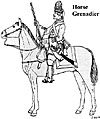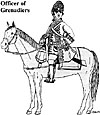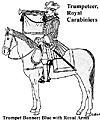During the first half of the C18th Spanish and Italian military units fought in Italy with the French against Imperial forces. Amongst those units that saw action were the mounted troops of the Spanish Royal Household. They were present on the battlefields of Lombardy and during the conquest of Naples; participated in the Siege of Capua and in the battle of Bitonto. Following the conquest of the southern Kingdom they were once more deployed in Lombardy.
As with much of the Spanish army, the Household troops were modelled along French lines. The mounted contingent comprised the Royal Horse Grenadiers and a Brigade of Carabiniers.
COMPANY OF THE ROYAL HORSE GRENADIERS
The Company of Royal Horse Grenadiers was created on December 26th, 1731 by uniting the grenadiers of the dragoon regiments of Belgia, Numancia, Batavia, Sagunto and Lusitania. A Royal order isues in 1753 establisheed that the Company should be composed of a commanding officer with the rank of Captain-Lieutenant, a Lieutenant, a sub-lieutenant, a Quarter-master, an Adjutant, 3 exempts, 3 Brigadiers, 6 sub- brigadiers. a cornet, 6 cadets, 9 ansepessades (corporals), 132 grenadiers, a drum major, 4 drummers, 6 hautbois, a chaplain, a surgeon, a saddler and a farrier.
 The compoany was divided into three brigades of 50 horses each. On campaign a Lieutenant, a sub-lieutenant and a Quartermaster were added to the company. At the end of the wars, in 1748, the Company was disbanded.
The compoany was divided into three brigades of 50 horses each. On campaign a Lieutenant, a sub-lieutenant and a Quartermaster were added to the company. At the end of the wars, in 1748, the Company was disbanded.
The uniform was inspired by that of the French Grenadiers a Cheval, and was blue with red cuffs, collar and turnbacksi the vest was similarly red with blue breeches. The coat was laced in silver with button holes similarly laced and a narrow silver border on the collar. Shabraque and holsters were blue with a silver border. Drummer and hautbois wore their uniforms richly laced in silver as in the French (and Spanish) Garde du Corps.
 Officers carried shoulder belts and
pouches covered with scarlet-red cloth,
bordered silver; on the pouch cover there was
a shield with the Royal Arms in silver.
Officers carried shoulder belts and
pouches covered with scarlet-red cloth,
bordered silver; on the pouch cover there was
a shield with the Royal Arms in silver.
De Clonard, in his HISTORY OF THE ROYAL HOUSEHOLD TROOPS supplied a reconstruction of the uniforms, giving them caps similar to those worn by French Grenadiers a Cheval in 1720, well known by means of the paintings of Delaistre. However, the afore-mentioned royal order and a series of contemporary watercolours in the Brown Collection show instead that during these campaigns Horse Grenadiers were equipped with bearskin caps similar to infantry grenadiers, with a red cloth bag laced and terminating in a silver tassel.
They were armed with a musket, bayonet and two pistols. A contemporary water colour shows the Company's guidon, that was deep red embroidered in silver. In the centre there was the regimental badge: Mount Aethna( Etna) erupting flames and rocks with these words: METUM SPARGIT STRAGEMQUE (It spreads fear and destruction).
THE BRIGADE OF CARABINIERS
 This was created on March 7th 1732. It
was considered the one of the premier units of
Spanish Cavalry, immediately following the
Companies of the Garde du Corps.
This was created on March 7th 1732. It
was considered the one of the premier units of
Spanish Cavalry, immediately following the
Companies of the Garde du Corps.
The Brigade comprised of four sqaudrons, each of three companies. Ecah company had a Captian, a Lieutenant, an ensign, two sergeants, a trumpeter, three corporals and 47 Carabiniers. The staff of the Brigade included a field offficer commanding it, a deputy commander, a Major, two adjutants, a chaplain, a surgeon, a kettle-drummer, a sadler and a merechal-ferrant .
Once again the uniform was inspired by the French corps of the same title, and as with all the Royal corps of the Bourbon dynasty, was dressed in red and blue.
Coat and breeches were blue, with a red collar, vest, cuffs, lining and turnbacks. The cuffs were bordered in silver. Butons were of tin. Neck tie was black, as was the hat with a silver border and fitting and a scarlet cockade (Black in 1741); deerskin gloves and black leather gaiters. Belts were white leather bordered silver. Shabraque and holsters were blue with a silver lace horder.
 The Colonel's squadron carried a white
ensign embroidered in silver, the remaining
three being blue. All had the Royal Arms
embroidered with silver, gold and coloured silk
on both sides. Musicians and trumpeters were
dressed as thos cof the Garde du Corps. i.e.
blue with silver lace all over the coat, crimson
cuffs, red breeches and vest.
The Colonel's squadron carried a white
ensign embroidered in silver, the remaining
three being blue. All had the Royal Arms
embroidered with silver, gold and coloured silk
on both sides. Musicians and trumpeters were
dressed as thos cof the Garde du Corps. i.e.
blue with silver lace all over the coat, crimson
cuffs, red breeches and vest.
Officers wore the same as troopers but with all lace & buttons in silver. Troopers were armed with a carbine, two pistols and a sword.
Large Illustrations (slow: 137K)
SOURCES
1) Ordenanza de 3. de Mayo de 1735 pare el servicio de la Compania de Granaderos a Cavallo del Rey.
2) Real Ordenanza de 7. de Marzo de 1732 pare la Formacion de la Brigada de Caravineros Reales
3) M Gomez Ruiz, V Alonso Juanola EL EJERCI TO DE LOS BORBONE, Madrid 1989.
4) Archivo di stato Napoli Carte Montemar ffss 36,94,97
5) Ann S R Brovn Collectin, Brown State University, Providence, Rhode Island.
6) De Clonard HISTORIA DE LAS TROPAS DE CASA REAL
7) Portugues COLLECCION DE LAS ORDE NANZAS MILTARES Madrid 1764
8) Biblioteca Nazioneale Napoli Ms CONQUISTA DELOS REINOS DE NAPOLES, Y SICILIA 1735
Back to 18th Century Military Notes & Queries No. 9 Table of Contents
Back to 18th Century Military Notes & Queries List of Issues
Back to Master Magazine List
© Copyright 1995 by Partizan Press
This article appears in MagWeb (Magazine Web) on the Internet World Wide Web.
Other military history articles and gaming articles are available at http://www.magweb.com